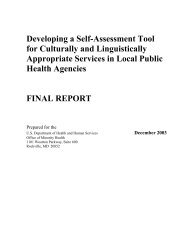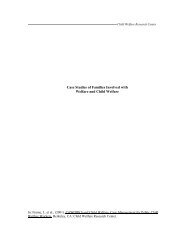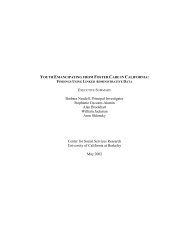Family Assessment in Child Welfare - Center for Social Services ...
Family Assessment in Child Welfare - Center for Social Services ...
Family Assessment in Child Welfare - Center for Social Services ...
You also want an ePaper? Increase the reach of your titles
YUMPU automatically turns print PDFs into web optimized ePapers that Google loves.
North Carol<strong>in</strong>a <strong>Family</strong> <strong>Assessment</strong> Scale (NCFAS) and Related Instruments. TheNCFAS (Reed-Ashcraft, Kirk, & Fraser, 2001) was developed <strong>in</strong> the mid-1990s to allowcaseworkers work<strong>in</strong>g <strong>in</strong> <strong>in</strong>tensive family preservation services (IFPS) to assess familyfunction<strong>in</strong>g at the time of <strong>in</strong>take and aga<strong>in</strong> at case closure. The 39-item <strong>in</strong>strument was designedto assist caseworkers <strong>in</strong> case plann<strong>in</strong>g, monitor<strong>in</strong>g of progress, and measur<strong>in</strong>g outcomes. TheNCFAS provides rat<strong>in</strong>gs of family function<strong>in</strong>g on a six-po<strong>in</strong>t scale rang<strong>in</strong>g from “clearstrengths” to “serious problems” <strong>in</strong> the follow<strong>in</strong>g five doma<strong>in</strong>s: (1) environment, (2) parentalcapabilities, (3) family <strong>in</strong>teractions, (4) family safety, and (5) child well-be<strong>in</strong>g. Internalconsistency and construct validity have been established <strong>for</strong> early versions as well as the mostrecent version of the NCFAS (Version 2.0; Reed-Ashcraft et al., 2001, Kirk et al., <strong>in</strong> press) andthe <strong>in</strong>strument is able to detect changes <strong>in</strong> function<strong>in</strong>g over time. The <strong>in</strong>strument also appears tohave some degree of predictive validity <strong>in</strong> relation to placement prevention; however, the authorscaution that the relatively weak capability of the <strong>in</strong>take rat<strong>in</strong>gs to predict placement at closure orthereafter suggest that the NCFAS should not be used as a device to screen out families fromservice at the time of <strong>in</strong>take (Kirk et al., <strong>in</strong> press). Additional research with sufficiently largesamples is necessary to establish predictive validity <strong>for</strong> outcomes of <strong>in</strong>terest.Figure 3. Promis<strong>in</strong>g Measures of Comprehensive <strong>Family</strong> <strong>Assessment</strong> <strong>for</strong> <strong>Child</strong> <strong>Welfare</strong> by<strong>Assessment</strong> Doma<strong>in</strong>InstrumentsPatterns of<strong>Social</strong>Interaction<strong>Family</strong> <strong>Assessment</strong> Doma<strong>in</strong>sBackgroundParent<strong>in</strong>gBasicofPracticesNeedsCaregiversOtherBehaviors andConditionsNorth Carol<strong>in</strong>a <strong>Family</strong><strong>Assessment</strong> Scale (NCFAS)X X X X XNCFAS-Reunification(NCFAS-R)X X X XStrengths and StressorsTrack<strong>in</strong>g Device (SSTD)X X X X X<strong>Family</strong> <strong>Assessment</strong> Form(FAF)X X X X X<strong>Family</strong> <strong>Assessment</strong> Checklist(FAC)X X X XAckerman-Schoendorf Scales<strong>for</strong> Parent Evaluation ofX X X X XCustody (ASPECT)Darl<strong>in</strong>gton <strong>Family</strong><strong>Assessment</strong> System (DFAS)X X X XX = assesses family function<strong>in</strong>g <strong>in</strong> this doma<strong>in</strong>10
















